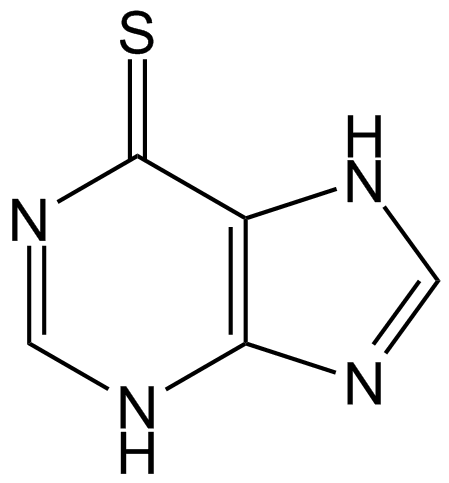Mercaptopurine (6-MP) |
| Catalog No.GC13704 |
La mercaptopurine (6-MP) est un analogue de la purine qui agit comme un antagoniste des purines endogènes et a été largement utilisé comme agent antileucémique et médicament immunosuppresseur.
Products are for research use only. Not for human use. We do not sell to patients.

Cas No.: 50-44-2
Sample solution is provided at 25 µL, 10mM.
6-Mercaptopurine is a purine analogue which acts as an antagonist of the endogenous purines and has been widely used as antileukemic agent and immunosuppressive drug.
6-Mercaptopurine hydrate (6-MP) induces NR4A3 transcriptional activity 1.6- to 11-fold (P<0.01) in a dose-responsive manner. It is found that 6-Mercaptopurine hydrate leads to a dose-dependent increase in NR4A3 protein levels. 6-MP treatment increases cell surface GLUT4 in both basal cells 1.8- to 3.6-fold (P<0.01) and insulin-stimulated cells 2.9- to 4.4-fold (P<0.01) over that in controls. It is also found that 6-Mercaptopurine hydrate increases phospho-AS160 significantly in a dose-responsive manner under both basal and insulin-stimulated conditions[2].
In the fetal telencephalons of the 6-Mercaptopurine hydrate (6-MP)-treated group, the S phase cell population increases at 36 and 48 h and returns to the control level at 72 h after treatment. The G2/M phase cell population begins to increase at 24 h, peaks at 36 h, decreases at 48 h, and finally returnes to the control level at 72 h. On the other hand, the sub-G1 phase cell population (apoptotic cells) begins to increase at 36 h, peaks at 48 h, and then decreases at 72 h[3].
Reference:
[1]. Sahasranaman S, et al. Clinical pharmacology and pharmacogenetics of thiopurines. Eur J Clin Pharmacol. 2008 Aug;64(8):753-67.
[2]. Liu Q, et al. 6-Mercaptopurine augments glucose transport activity in skeletal muscle cells in part via a mechanism dependent upon orphan nuclear receptor NR4A3. Am J Physiol Endocrinol Metab. 2013 Nov 1;305(9):E1081-92.
[3]. Kanemitsu H, et al. 6-Mercaptopurine (6-MP) induces cell cycle arrest and apoptosis of neural progenitor cells in the developing fetal rat brain. Neurotoxicol Teratol. 2009 Mar-Apr;31(2):104-9.
Average Rating: 5 (Based on Reviews and 34 reference(s) in Google Scholar.)
GLPBIO products are for RESEARCH USE ONLY. Please make sure your review or question is research based.
Required fields are marked with *




















